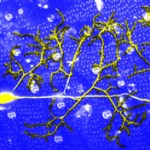metamorphosis
Artist's rendition of dendrite regeneration in a fruit fly during metamorphosis. (Chay Kuo Lab, Duke University)
Researchers at Duke University are interested in understanding the metamorphosis of fruit flies from larvae to adult stage in an effort to understand how the insects grow new nerve endings as they undergo this transition. What is interesting is that the flies lose neurons they will not need as an adult and will grow new nerve endings. According to a press release from Duke University, a protein called Cysteine proteinase-1 (Cp1) is important in the regeneration step. In fact,…
Tenebrio molitor, pupa
Tenebrio molitor is a darkling beetle known more for its immature stages than for its adults. It is the ubiquitous mealworm. You can buy these granivorous beetles at any pet store as food for fish, birds, and reptiles.
The above shot of a developing pupa requires two sources of light. A flash head positioned behind the insect backlights the subject to produce the translucent glow. A second, positioned above and in front, is powered down and provides the highlights and details of the head and appendages.
Tenebrio molitor larva and pupa
Stronger backlighting gives…
Here's an image for the textbooks:
Ants, like butterflies, pass through egg, larva, and pupa phases on their way to adulthood. While in Florida earlier in this summer I found a nest of the twig ant Pseudomyrmex gracilis with brood present in all stages, providing the material to make these images.
The key was placing the developing ants on a glass slide. This provided distance between them and the cardboard background, so that the backdrop is blurred while the insects remain in sharp focus. These images are not what I'd call fine art, but I'm happy with them as solid…
Whalefishes, bignoses and tapetails - these three groups of deep-sea fishes couldn't look more different. The whalefishes (Cetomimidae) have whale-shaped bodies with disproportionately large mouths, tiny eyes, no scales and furrowed lateral lines - narrow organs on a fish's flanks that allow it to sense water pressure.
The tapetails (Mirapinnidae) are very different - they also lack scales but they have no lateral lines. They have sharply angled mouths that give them a comical overbite and long tail streamers that extend to nine times the length of their bodies.
The bignoses (…
The transformation from caterpillar to butterfly or moth is one of the most beguiling in the animal world. Both larva and adult are just stages in the life of a single animal, but are nonetheless completely separated in appearance, habitat and behaviour. The imagery associated with such change is inescapably beautiful, and as entrancing to a poet as it is to a biologist.
According to popular belief, within the pupa, the caterpillar's body is completely overhauled, broken down into a form of soup and rebuilt into a winged adult. Richard Buckmister Fuller once said that "there is nothing in a…
Igor Siwanowicz, who shot this series of a fly breaking free of its puparium, is among the finest studio photographers of insects. He's got a particularly sharp eye for lighting and his compositions are often playful. Go visit Igor's portfolio.
